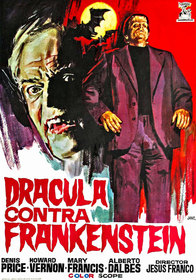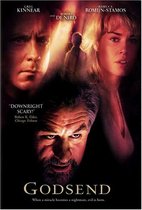Our editor-in-chief Nate Yapp is proud to have contributed to the new book Hidden Horror: A Celebration of 101 Underrated and Overlooked Fright Flicks, edited by Aaron Christensen. Another contributors include Anthony Timpone, B.J. Colangelo, Dave Alexander, Classic-Horror.com's own Robert C. Ring and John W. Bowen. Pick up a copy today from Amazon.com!
Dracula, Prisoner of Frankenstein (1972)
There are some movies that are avant-garde in their disuse of dialog. There are some movies that are brilliantly post-modern in leaving out most of the soundtrack. There are movies that are insightful because of their dubious logic and shifting plot. Dracula, Prisoner of Frankenstein isn’t any of those films. It’s possible that I might have missed something on the first viewing, some nugget of inspiration that I’d pick up on if I watched the film again. Unfortunately, you couldn’t pay me to watch Prisoner of Frankenstein a second time. I probably should have skipped it the first time around.
Dracula, Prisoner of Frankenstein is difficult to synopsize, since, to be honest, I’m not too sure what was happening for most of the movie. I can, however, identify a few key plot points, though it isn’t easy. To make a long, long story reasonably short, Dracula is ravaging the countryside, and then a local doctor stakes him and he turns into a dead bat. Shortly afterwards, Dr. Frankenstein moves into town, rolls out the Monster, revives Dracula by putting the bat into a jar of blood, and is well on his way to creating an army of darkness. The good doctor, John Seward, returns to vanquish Dracula and Dr. Frankenstein, and shut down the whole operation. And there’s a werewolf. I have no idea where the werewolf came from or why it’s there.
In case you hadn’t figured it out, the biggest problem with Dracula, Prisoner of Frankenstein is that the plot is difficult, if not impossible, to follow. The above is summarized from, roughly, one-third of the film. As for the remaining two-thirds, it’s kind of hard to say. Stuff happens. Girls get bitten by vampires, Dr. Frankenstein mills about looking sinister, there’s a strange village witch girl who pops up and offers sage advice. None of it really connects together, making it really hard to understand exactly how we got from point A to point B. Characters appear and disappear, often without any explanation as to why they’re there. Stuff happens to them, and then we never see them again. Particularly vexing is the French dancer, who is drained of blood by Dr. Frankenstein to revive Dracula. A lot of time is spent on her – we see her entire song and dance, and actually come to like her, before she’s swept up by Frankenstein’s monster and butchered in the lab. However, rather than providing a meaningful character connection, it just leaves us wondering “Why her?”. There’s no explanation of who she is or why she’s chosen, and then Dracula is alive and the girl, so carefully introduced, is gone. It’s downright bewildering.
It’s entirely possible that these plot holes might have been patched up if the script had included any significant amount of dialog. However, for some reason, the screenwriters of Prisoner of Frankenstein (Franco and Paul D'Ales) seem to be diametrically opposed to any of that talking nonsense. No one talks if they can help it. We don’t have any discourse in the film for the first 16 minutes, and then all we get is a mysterious chant performed by the local town witch. Silent film is great, I will admit – but only when the script and directing is careful crafted to tell that story without conversation. No such careful consideration was given to Prisoner of Frankenstein, which left many scenes completely without context. I could see what the characters were doing, like biting a helpless woman or skulking about a castle, but I had no idea why they were doing it, how they got there or why it might be important.
There are only two real instances in the film when people talk with each other for any length of time: Frankenstein’s monologues, or the town witch convincing Seward to go after Dracula again. Every so often, Frankenstein writes in a journal or thinks to himself, and we’re be privy to his thoughts. It’s how we discover that his nefarious plan is to create an army of monster-slaves. Unfortunately, while there are several such monologues, they all basically go over the same information. Soon he will rule an army of evil, soon he will be the evil overlord. Ad infinitum. He never really says anything new. Our friendly neighborhood witch, on the other hand, really only speaks up when she tells Seward that he has to go after Frankenstein and his monsters, even though he got beat up last time. Oh, and by the way, it’s the full moon so watch out for those werewolves. She doesn’t bother to explain where the werewolf came from or why it’s hanging around. Pity.
As if the closed-lipped script wasn’t bad enough, the film isn’t even filled in with music. Long stretches of silence prevail, unless something very ominous, violent or spooky is going to happen. And then the music isn’t terribly noteworthy. I’d be very hard-pressed to tell you anything that stood out about it, because, frankly, I barely noticed it was there. It was exactly what you’d expect -- all strings and eerie notes. It added absolutely nothing new or interesting to an already dull film.
Unfortunately, the visuals of the film are not enough to support to the flimsy plot, the non-existent dialog, or the unremarkable music. The directing was competent. Jesus Franco didn’t really do anything wrong directing Prisoner of Frankenstein; he just didn’t do anything particularly right. The lighting is nondescript, lighting the necessary plot features but failing to provide any real sense of mood. The camera oscillates rather predictably between medium shots and close-up shots. And, finally, the colors are the colors such things should be: the blood was red, Frankenstein’s monster was green, the witch’s hair was black. There was nothing creative to be found in the visual, at all.
Dracula, Prisoner of Frankenstein, was downright disappointing. It was confusing, and worse, it was boring. Prisoner of Frankenstein is so bad, I can’t even think of a way to make fun of it effectively. That, right there, is 90 minutes of my life I want back.
This review is part of Spanish Horror Week, the second of five celebrations of international horror done for our Shocktober 2008 event.








